Yesterday I played my first live, in-person chess game since the coronavirus pandemic started, in early March. To be precise, March 3 was the last date when the chess club at Aptos Library met. Most likely I played one of the kids that day, although I don’t specifically remember a game. The next week, March 10, I cancelled the club meeting, after my assistant (Shan Crockett) said that he wasn’t going to come. I haven’t sat across the board from a person since then — only a computer.
However, I’ve been meeting with two of my favorite students, Emmy and Ryder, via Zoom for the last three weeks. They recently celebrated their 12th and 9th birthdays, respectively. Hooray for them!
Their parents, Scott and Shelley, mentioned that they had a plum tree that was producing lots of fruit, and I mentioned that I had tomato plants that were practically bursting, and so the idea of a plums-for-tomatoes trade was hatched. Here was my contribution to the swap.
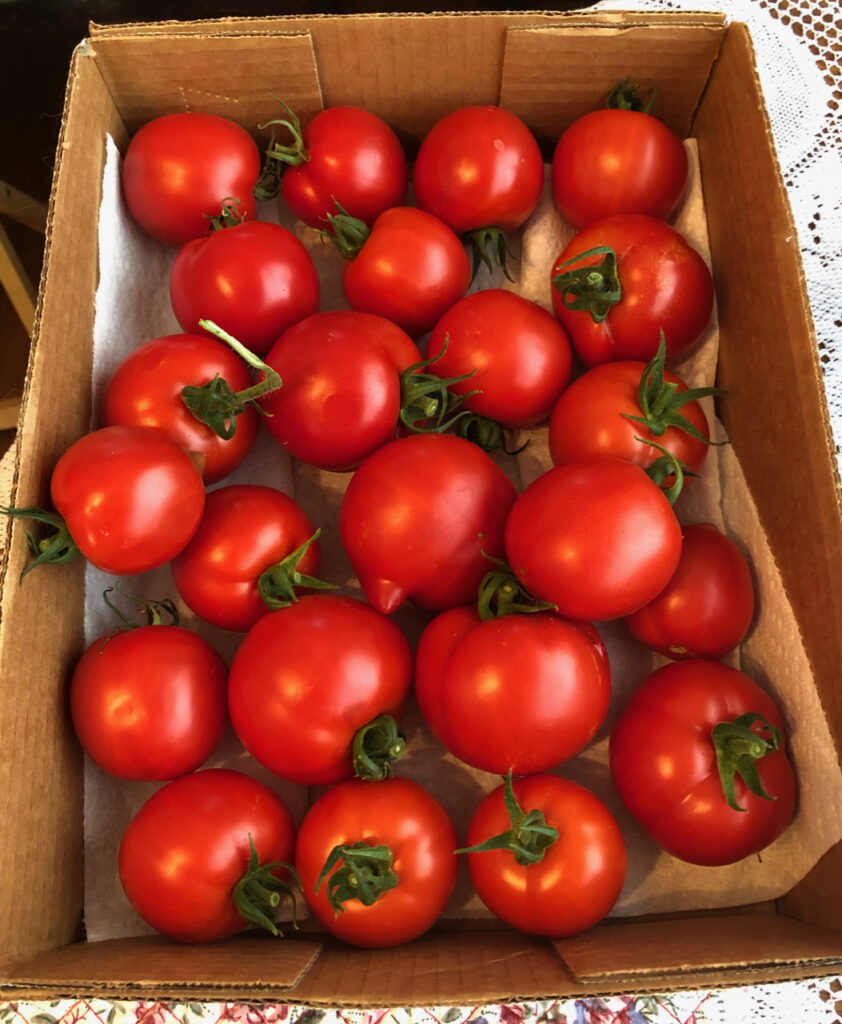
We decided also to try a chess lesson, with safe social distancing. Scott and Shelley set up a table outside, with two large boards at opposite ends of the table so that I could use one board and Emmy and Ryder could use the other. (In fact there were several boards at the table. They have lots of chess boards.)
First, we played a consultation game (me against Emmy and Ryder and a little bit of contribution from Scott), which led into a pretty good lesson. Then Ryder wanted to play 5-minute chess, and that’s when things got interesting!
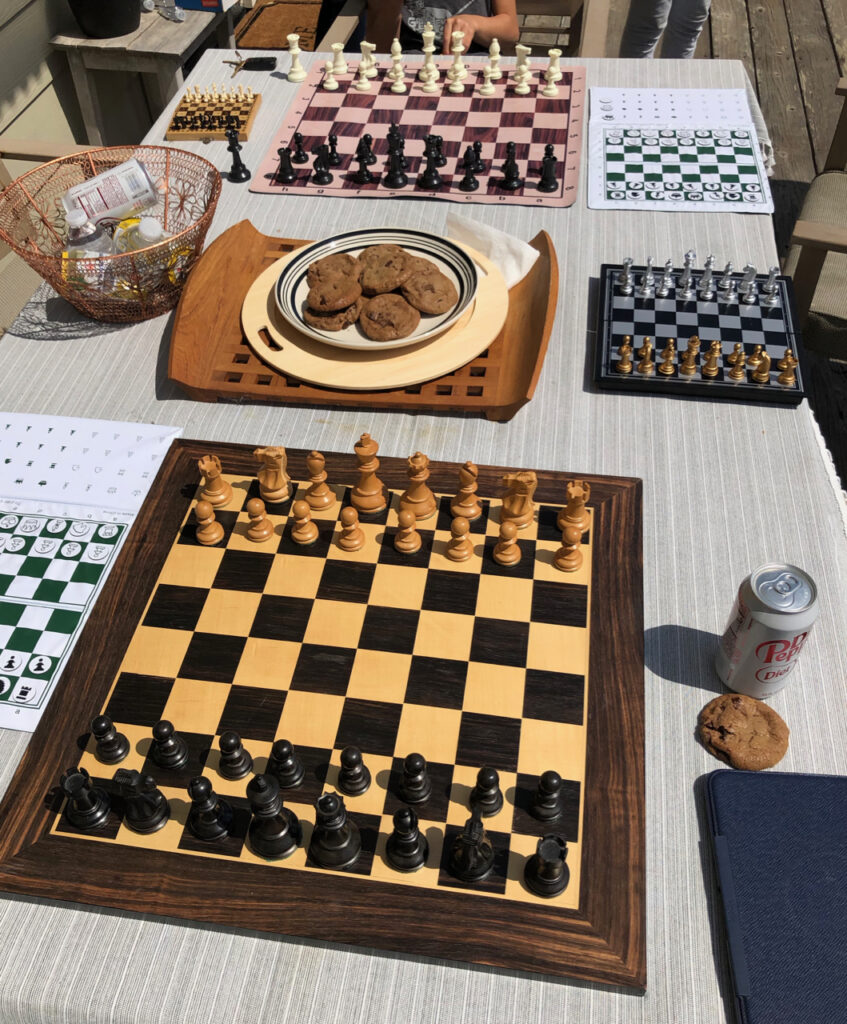
I had actually seen a photograph on Facebook of people playing in a chess club in Europe with exactly this setup — two boards and a clock in the middle. We put the clock roughly where the chocolate chip cookie plate is in this photo. I’ll call this setup Coronavirus Chess. When you make your move, you have to tell your opponent what it is (although in practice, it was just as easy to see the move).
My first game of Coronavirus Chess was not exactly a thing of beauty. It took longer than I expected to go through this procedure of making the move, saying the move aloud, reaching halfway across the table and pressing the clock button. No matter how fast I tried to play, my time was just melting away. Ryder and I both got in time pressure. Then we found out an even bigger problem with Coronavirus Chess.
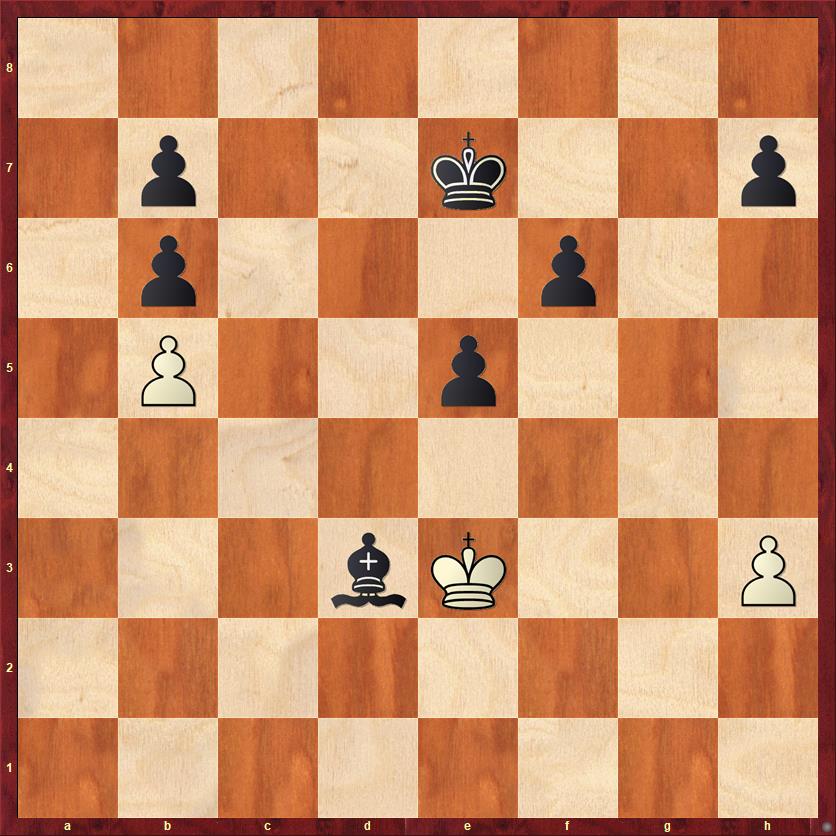
FEN: 8/1p2k2p/1p3p2/1P2p3/8/3bK2P/8/8 b – – 0 39
Ryder is playing White and I’m playing Black. Although I’m obviously winning on the board, the clocks are another matter: I was down to 8 seconds. Ryder had about the same amount of time. I played 39. … Bxb5. But somehow or other, Ryder didn’t make the move on his board, and so he (thinking my bishop was still on d3) played “40. Kxd3.” I tried to explain that it was an illegal move, but I saw that I was down to 4 seconds and so I played “40. … Bxd3.” Now we have two different positions on two different boards, one with his king on d3 and the other with my bishop on d3!
Now as we’re trying to figure out who is on d3, and I’m trying to explain at the same time that in speed chess (unlike tournament chess) it’s legal to take the king, my flag falls. So, who wins? Me, because I took his king? Ryder, because my flag fell? And what exactly do the Rules of Chess say to do when the two players have different positions on their boards?
Well, it’s all beyond me. This was just a friendly game, after all. I’d rather focus on how well Ryder played. He didn’t make any really serious mistakes in this game until move 33, when his time pressure was already pretty severe. I think he played better than me for quite a while. Keep in mind that his rating is under 1000 and mine is close to 2200!
Ryder – Dana: 1. e4 d5 2. Nf3?! … (Ryder is used to playing against Emmy, who always plays 1. … e5, and I don’t think he even looked at my move before touching his knight. Actually, 2. Nf3 isn’t all that bad, and he follows it up very well!)
2. … de 3. Ng5 Qd5 4. d3! … (Forced, but good.)
4. … ed 5. Nc3! … (Very nice. Gaining tempi, not worrying too much about material.)
5. … Qe5+ 6. Be3 e6 7. Nf3 Qa5 8. Bxd3 Bb4 9. Bd2! Nf6 10. a3! … (He’s playing exactly the moves I would play as White. By now White has pretty good compensation for the pawn.)
10. … Bxc3+ 11. Bxc3 Qb6 12. O-O Nbd7 13. Qe2 O-O 14. h3 Nd5 15. Qd2 … (Probably 15. Bd2 is better, recognizing that the pawn on b2 is poisoned. Fritz says 15. Bd2 Qxb2 16. c4! Nc3! 17. Bxh7+ recovering the pawn, with a slight advantage to White.)
15. … Nxc3 16. Qxc3 Nc5 17. b4?! … (Not only does Ryder not avoid the trade on d3, he actually provokes it. To me this was a little bit of a “beginner mistake,” but it led me to relax and make a much worse blunder of my own.)
17. … Nxd3 18. Qxd3 c5? (A really bad move on my part. After 18. … f6 preparing … e5, Black has a healthy extra pawn.)
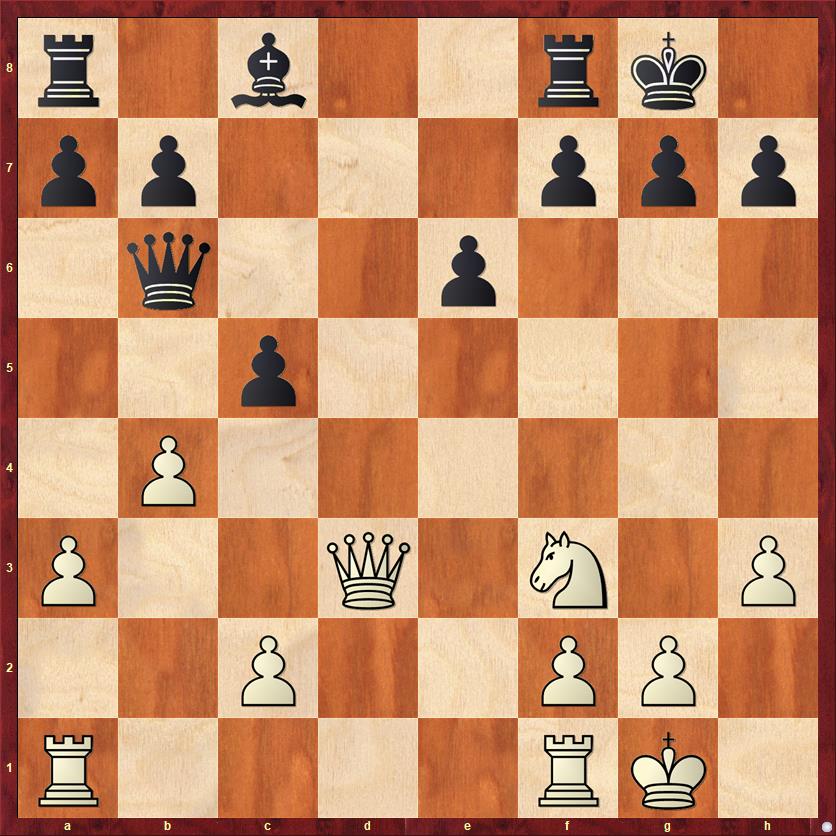
FEN: r1b2rk1/pp3ppp/1q2p3/2p5/1P6/P2Q1N1P/2P2PP1/R4RK1 w – – 0 19
This is a somewhat ironic position, where the “beginner move” for White might be better than the “sophisticated move.” Fritz points out that 19. Ng5! is quite effective. Either 19. … g6 or 19. … f5 would give me huge weaknesses. For example, after 19. Ng5 g6 20. Qc3 cb 21. ab f6 22. Ne4 e5 23. Rfd1, White has the very inconvenient threat of Rd6. Fritz says that it’s completely equal.
Instead Ryder plays a more sophisticated move, which is exactly what I would have played. I will give it an exclamation mark even though the computer disagrees.
19. Qe3! cb 20. Qxb6 ab 21. ab Bd7 22. Rxa8 Rxa8 23. Rd1 Bc6 24. Ne5! … (Several times in this game I had the experience of thinking, “It would be annoying if Ryder played X,” and then he immediately played X. It happened on moves 5, 9, 10, 19, and now.)
24. … Kf8
This is another move where I have to disagree with the computer. Fritz recommends the very ugly 24. … b5. Maybe in some ideal computer sense it’s right, but I actually think that 24. … Kf8! was an important decision and a key turning point. There are times in a chess game when you have to say, “Okay, this is not working out,” and hit the re-set button. That’s what I’m doing here. I’m going to improve my king position so I don’t get mated, and then I am going to try to win whichever endgame I end up in.
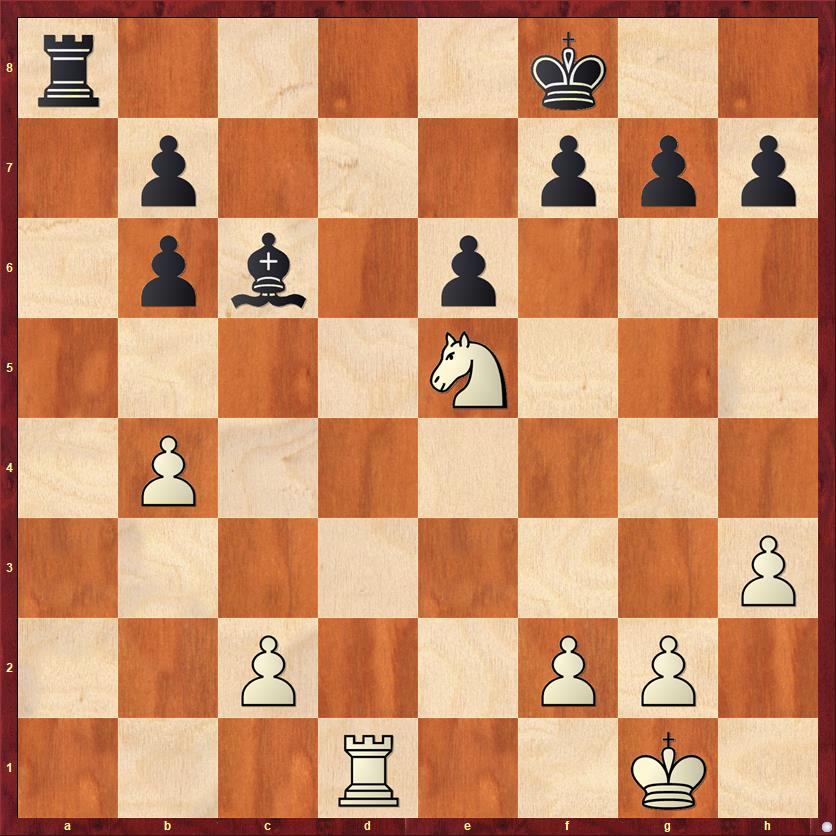
FEN: r4k2/1p3ppp/1pb1p3/4N3/1P6/7P/2P2PP1/3R2K1 w – – 0 25
White’s decision here is pretty tricky. I think that Ryder’s choice was not the best, but very reasonable.
For White, the best shot at fully equalizing is 25. Nd7+! Fritz thinks (and I think) that White is doing fine after either 25. … Ke7 (which is what I probably would have played) or after 25. … Bxd7.
Many people might be tempted to trade pieces the other way: 25. Nxc6 bc. After 26. Rd7 Ra1+ 27. Kh2 Rc1 28. Rd2, Black has the better of the rook endgame, as his rook is active while White’s is passive. More interesting would be 26. Rd6! Rc8 27. Rd7. The point of this two-step is to make Black put his rook in a more passive location. But that would be a pretty sophisticated idea for an under-1000 player to find!
Interestingly, Ryder chose not to trade pieces, which is counter to his usual tendency. I think he must have felt, intuitively, that his knight was a better piece than my bishop, so he didn’t want to give it up. I don’t want to criticize his next move too harshly. First, I think he has been too prone to mindless exchanges in the past, and I’m glad to see him thinking before taking. Second, he has a concrete plan. I like to see planful play from my students. It’s just not the optimal plan for this position.
25. c4?! Ke7 26. b5 Be8
To Ryder, this move probably looked like a retreat. But actually, Black’s position is getting more compact and more solid. The bishop will re-emerge on f7, and it will be a much better piece than White’s knight. Black’s extra pawn will finally start to make a difference after … f6 and … e5.
27. g4 f6 28. Nf3 e5 (For the the first time all game I really feel comfortable with my position.)
29. Re1 Bf7 30. g5 Bxc4 31. gf+ gf 32. Rc1 Bd5 33. Rd1? … (Until now, Ryder has played 32 moves that have not had any serious faults. He’s made mistakes, but they were subtle ones: misjudging the value of certain trades, coming up with plans that were good but not the best. Now, with both players under 30 seconds for the rest of the game, his haste finally gets the better of him. But all in all he played very well.)
33. … Bxf3 34. Rd3 Rg8+ 35. Kh2 Rg2+ 36. Kh1 Rxf2 37. Kg1 Be2 38. Kxf2 Bxd3 39. Ke3 Bxb5, Game ends in confusion.
And now we have arrived at the position we started with. Ryder played “40. Kxd3” and I played “40. … Bxd3” and then my flag fell while we were trying to figure out what was going on. Oh well.
One lesson I’ve learned from this is that if you’re going to play Coronavirus Chess, you have to do it with a time delay. Next time I’ll ask for at least a three-second delay.
In spite of this strange interlude, I enjoyed being outside, talking with the kids and their parents, breathing in the fresh air, and playing some version of chess. I think you don’t appreciate what you have until you lose it for a while.



{ 4 comments… read them below or add one }
This suggests a market for a longclock: two half-clocks with 10′ of cable between them!
Your kids sound great. My after-school chess club dwindled to two with the switch to Zoom, but the remaining two are very keen, and one of them sacked his queen (correctly!) against me in an analysis game a couple weeks ago. Couldn’t have been happier if I’d played it myself.
The longer time it takes to focus, the more difficult it is for the child and the results are worse. IIt’s important to know, it might sound obvious, but isn’t so, that you can do it from a very young age and you don’t have to explain it with proper rules. Why? This is the obvious part – because there is no fun in it. But with books like this, by Richard James, or like the one writen by Makism Aksanov (net-boss.org/chess-puzzles-for-kids-by-maksim-aksanov) and by many, many more chess entthusiasts, it’s very easy to teach with all the fun and play, and make with this game a very rich, fantasy world of our kids 🙂
I must say that thanks to all the covid situation, I started to play chess with my kids. In my childhood I was a member of the chess club but when I graduate from high school, there was many more “interesting” things to do. Now, after 20 years, in this new situation, when my sons were almost flying in the apartment, I had to do something about all the boredom. Chess was not so obvious choice, because how to interest 5 and 7 yo guys with some old bord game? But I startet to google about new methods of introducing chess to kids. I found some auto chess games, it’s a nice way to use chess in the computer world, but it’s still some screen time, so I ordered also Story Time Chess board game, which is briliant for kids. Also I found some books, from which I can recommend one by Makism Aksanov (net-bossorg/chess-puzzles-for-kids-by-maksim-aksanov) or the classic position by Richard James.
If you’d asked yourself the Mike Splane question, “how am I going to win this game?”, before making your 18th move you would have saved yourself a lot of grief. You pointed out the correct answer in your note. Play f6, e5, Be6 and start trading pieces. There is absolutely no risk of losing and very high likelihood of winning the pawn-up ending. Why complicate things?